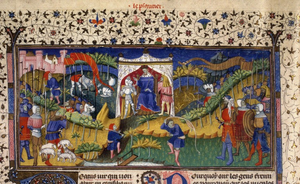[caption id="" align=“alignright” width=“250” caption=“15th-c. Illumination (Photo credit: Wikipedia)”] 
First Samuel 18:6 describes David’s return after killing Goliath ( 1 Sam 17:41–58). Precisely how this event sits chronologically in relationship to the surrounding narrative is difficult to establish. 1 One good way of reading the narrative, however, involves treating 1 Sam 18:1–5 as an extended parenthesis, which includes some foreshadowing, and understanding 1 Sam 18:6 to be bringing the reader back to the main plot line that had temporarily paused with 1 Sam 17:58. 2 In this context, it begins to be said הכה שׁאול֙ באלפו ודוד ברבבתיו ( 1 Sam 18:7; Saul has slain by his thousands and David by his ten thousands; see also 1 Sam 21:11; 29:5). 3 Yet, thus far, David has specifically been reported to have killed only one person (Goliath) and some animals ( 1 Sam 17:34–37)—not רבבת (ten thousands). 4 Rather, the women’s song quantitatively represents the qualitative value of David’s victory over Goliath as it relates to Saul’s previous exploits. 5 On hearing this song, then, Saul becomes enraged and starts looking and acting to do David harm ( 1 Sam 18:8–9).
Not dissimilarly did a later Saul also act against a later David (cf. Jer 30:9; Ezek 34:23–24; 37:24–25). 6 Although the former Saul perhaps did so from envy and the later from zeal (cf. Rom 10:1–2; Gal 1:13–14; Phil 3:4b–6), they both found themselves standing against the one on whose side יהוה stood ( 1 Sam 16:14; 17:37; 18:12, 28; Acts 26:14). 7 Although they were, in some ways, outstanding among their fellows (e.g., 1 Sam 9:2; 11:1–15; Gal 1:13–14; Phil 3:4b–6), the persecution in which they engaged was without any just cause ( 1 Sam 23:24b– 24:22; 26:1–25; Acts 9:4–5; 22:7–8; 26:14–15). 8 Yet, despite some more positive moments of lesser tension in the relationship between the former Saul and the former David (e.g., 1 Sam 24:16–22; 26:21–25), this Saul dies by his own hand ( 1 Sam 31:4). 9 Only in the case of the later Saul does the persecutor ultimately capitulate to the goodness of the one with whom יהוה stands and die by Torah in order to live in faithfulness and join with those who announce goodness of the Davidic Messiah, who has himself delivered his people from the one who had held them in terror ( Gal 1:11–24; 2:19–20; Heb 2:14–15; cf. 1 Sam 17:11, 24). 10
1. E.g., K&D, Samuel, 490–91n1; cf. Walter Brueggemann, “Narrative Coherence and Theological Intentionality in 1 Samuel 18,” CBQ 55, no. 2 (1993): 243; Antony F. Campbell, “The Reported Story: Midway between Oral Performance and Literary Art,” Semeia 46 (1989): 77–85; Simon J. De Vries, “David’s Victory over the Philistine as Saga and as Legend,” JBL 92, no. 1 (1973): 23–24, 35–36.
2. Burke O. Long, “Framing Repetitions in Biblical Historiography,” JBL 106, no. 3 (1987): 396; cf. Jerome, Ep., 46.2 ( NPNF2, 6:61).
3. Brueggemann, “1 Samuel 18,” 238. The term רבבת does not itself designate an exact quantity, but it and its context do ascribe to David a significantly greater quantity of slaughter than to Saul ( 1 Sam 18:7–8; Brueggemann, “1 Samuel 18,” 228–29, 239; R. P. Gordon, I & II Samuel: A Commentary [LBI; Grand Rapids: Zondervan, 1986], 160; HALOT, “רבבה”; Katherine Stott, “Herodotus and the Old Testament: A Comparative Reading of the Ascendancy Stories of King Cyrus and David,” SJOT 16, no. 1 [2002]: 63).
4. Based on David’s description in 1 Sam 17:14–15, 28, 33, 38–39, 42, 55–56, 58, 1 Sam 16:18 likely concerns David’s confrontation with the beasts that he mentions later ( 1 Sam 17:34–37; K&D, Samuel, 478–79). Or, the narrative of 1 Sam 16:14–23 may be a flash-forward to the parallel material in 1 Sam 18:10a (cf. Brueggemann, “1 Samuel 18,” 238; Chrysostom, Hom. 2 Cor., 24.4 [ NPNF1, 12:393]). Moreover, according to 1 Sam 17:52, אנשׁי ישׂראל ויהודה (the people of Israel and Judah), or probably more simply, בני ישׂראל ( 1 Sam 17:53; the children of Israel), are said to have routed the remainder of the Philistine army. To be sure, the narrative represents David’s defeat of Goliath was the catalyst for this larger victory. Yet, at this point, (1) אנשׁי ישׂראל ויהודה (the people of Israel and Judah) were certainly not under David’s command ( 1 Sam 17:12–20, 28, 33, 42) and (2) the text does not necessarily imply that David accompanied the rest of the people in their pursuit after the remainder of the Philistine army ( 1 Sam 17:51a, 54, 57). Indeed, even in such a pursuit, unless David had carried with him some weapon from the battlefield itself (e.g., Goliath’s sword; 1 Sam 17:50–51), after killing Goliath, David hardly seems to have been armed with more than a staff and four stones for his sling (cf. 1 Sam 17:40, 50).
5. Even the numbers of enemies later reported to have been killed in particular engagements by David’s שׁלֹשׁת הגברים (three mighty men) and their close associates pale in comparison (e.g., 2 Sam 23:8–23; 1 Chron 11:10– 12:22).
6. Cf. Irenaeus, Haer., 4.27.1 ( ANF, 1:498).
7. Chrysostom, Hom. 2 Cor., 24.4 ( NPNF1, 12:393); Irenaeus, Haer., 4.27.1 ( ANF, 1:498); Tertullian, Praescr., 3 ( ANF, 3:244).
8. Augustine, The Correction of the Donatists, 2.9 ( NPNF1, 4:636); Irenaeus, Haer., 4.27.1 ( ANF, 1:498); Tertullian, Praescr., 3 ( ANF, 3:244).
9. Chrysostom, Hom. 2 Cor., 24.4 ( NPNF1, 12:393).
